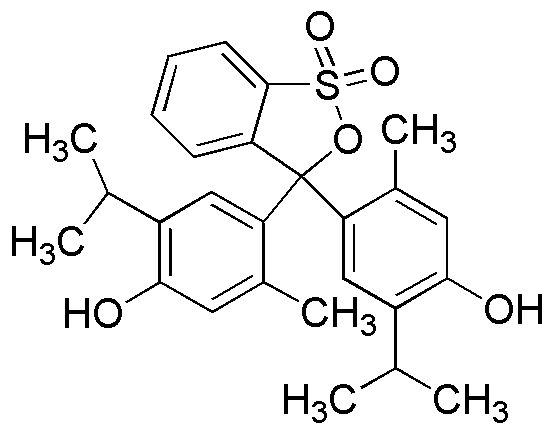Thymolphthalein is widely utilized in research focused on:
- pH Indicator: Commonly used in titrations, it changes color from colorless to blue at a pH range of 9.3 to 10.5, making it ideal for determining the acidity or alkalinity of solutions.
- Laboratory Experiments: Frequently employed in educational settings to demonstrate acid-base reactions, providing a visual representation that enhances learning and understanding.
- Biochemical Research: Utilized in studies involving enzyme activity and metabolic processes, helping researchers track changes in pH during reactions.
- Cosmetic Formulations: Incorporated in products to indicate pH levels, ensuring formulations are safe and effective for skin application.
- Environmental Monitoring: Used in assessing water quality, as it can indicate changes in pH levels in various aquatic environments, aiding in ecological studies.
General Information
Properties
Safety and Regulations
Applications
Thymolphthalein is widely utilized in research focused on:
- pH Indicator: Commonly used in titrations, it changes color from colorless to blue at a pH range of 9.3 to 10.5, making it ideal for determining the acidity or alkalinity of solutions.
- Laboratory Experiments: Frequently employed in educational settings to demonstrate acid-base reactions, providing a visual representation that enhances learning and understanding.
- Biochemical Research: Utilized in studies involving enzyme activity and metabolic processes, helping researchers track changes in pH during reactions.
- Cosmetic Formulations: Incorporated in products to indicate pH levels, ensuring formulations are safe and effective for skin application.
- Environmental Monitoring: Used in assessing water quality, as it can indicate changes in pH levels in various aquatic environments, aiding in ecological studies.
Documents
Safety Data Sheets (SDS)
The SDS provides comprehensive safety information on handling, storage, and disposal of the product.
Product Specification (PS)
The PS provides a comprehensive breakdown of the product’s properties, including chemical composition, physical state, purity, and storage requirements. It also details acceptable quality ranges and the product's intended applications.
Certificates of Analysis (COA)
Search for Certificates of Analysis (COA) by entering the products Lot Number. Lot and Batch Numbers can be found on a product’s label following the words ‘Lot’ or ‘Batch’.
*Catalog Number
*Lot Number
Certificates Of Origin (COO)
This COO confirms the country where the product was manufactured, and also details the materials and components used in it and whether it is derived from natural, synthetic, or other specific sources. This certificate may be required for customs, trade, and regulatory compliance.
*Catalog Number
*Lot Number
Safety Data Sheets (SDS)
The SDS provides comprehensive safety information on handling, storage, and disposal of the product.
DownloadProduct Specification (PS)
The PS provides a comprehensive breakdown of the product’s properties, including chemical composition, physical state, purity, and storage requirements. It also details acceptable quality ranges and the product's intended applications.
DownloadCertificates of Analysis (COA)
Search for Certificates of Analysis (COA) by entering the products Lot Number. Lot and Batch Numbers can be found on a product’s label following the words ‘Lot’ or ‘Batch’.
*Catalog Number
*Lot Number
Certificates Of Origin (COO)
This COO confirms the country where the product was manufactured, and also details the materials and components used in it and whether it is derived from natural, synthetic, or other specific sources. This certificate may be required for customs, trade, and regulatory compliance.


